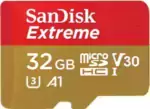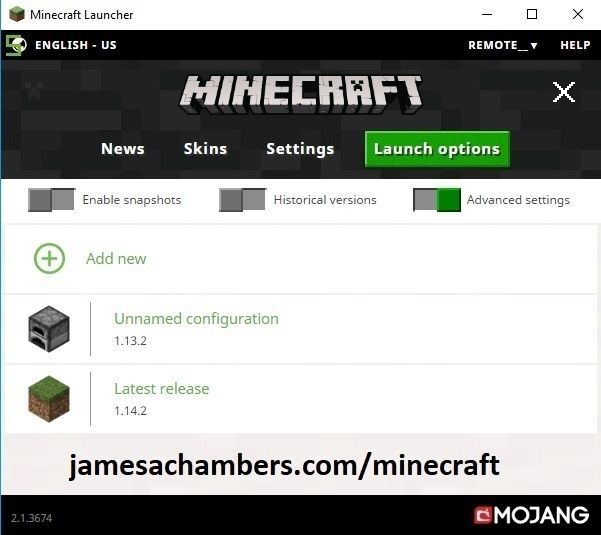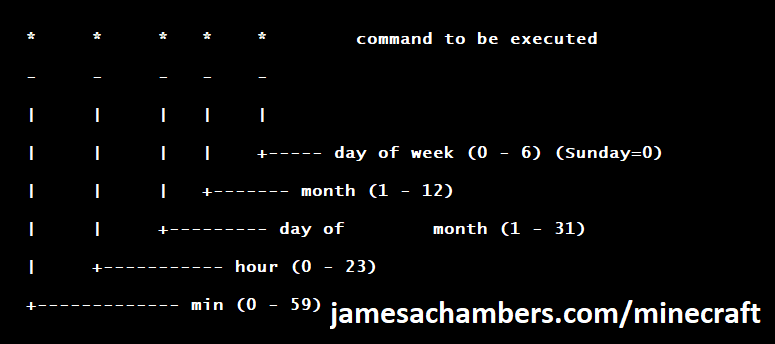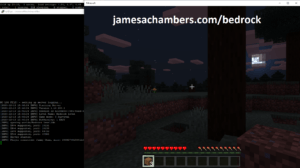
Minecraft 1.17 (Caves and Cliffs Update) is here! This script and guide are written to help you get a great performing Raspberry Pi Minecraft server up and running in only a few minutes.
This is the standalone version. It runs on most flavors of Linux and should work on most architectures as well (arm, aarch64, etc.).
I highly recommend using Docker over the standalone version for most people. Installing Docker is as simple as sudo apt install docker.io. There are 3 Docker options available:
- The Docker version that has Geyser + Floodgate installed (allowing people running Minecraft Bedrock Edition such as on iOS, Android, and console to connect)
- The Docker version that runs the Purpur Minecraft server with Geyser + Floodgate installed (allowing people running Minecraft Bedrock Edition to connect)
- The Docker version that only includes the Paper Minecraft server (the same as this standalone version)
It’s now possible to convert your worlds between Bedrock and Java versions. Check out my guide on Chunker here for more information.
Features
- Sets up fully operational Minecraft server in a couple of minutes
- Runs the highly efficient “Paper” Minecraft server
- Raspbian / Ubuntu / Debian distributions supported
- Installs and configures OpenJDK 18
- Sets up Minecraft as a system service with option to autostart at boot
- Automatic backups to minecraft/backups when server restarts
- Updates automatically to the latest version when server is started
- Easy control of server with start.sh, stop.sh and restart.sh scripts
- Optional scheduled daily restart of Pi using cron
Requirements
- Raspberry Pi model with 1 GB of RAM or higher. Basically a Raspberry Pi 2B or higher. (No Zero unfortunately, 512MB is not enough RAM to do this, I’ve tried!)
- Headless Linux distribution such as Raspbian Buster Lite, Ubuntu Server 18.04.2, or any Debian based distribution (GUI distros can be used at the expense of available RAM and server performance)
- Solid state drive highly recommended but not required.
You can get a SSD setup on a Pi for less than most Micro SD cards cost. See my article here for details - If using MicroSD you want to be using a high range card otherwise you will really be hurting on IO when the server is reading/writing chunks of terrain! Click here for MicroSD card benchmarks/recommendations.
Recommended Gear


The Raspberry Pi 4 is available in different memory configurations all the way up to 8 GB. It’s about the size of a credit card and uses an extremely low amount of power making it ideal for all sorts of projects and ideas!
Links: Amazon.com*, AliExpress*, Amazon.ca*, Amazon.com.au*, Amazon*.co.jp*, Amazon.co.uk*, Amazon.de*, Amazon.es*, Amazon.fr*, Amazon.it*, Amazon.nl*, Amazon.pl*, Amazon.se*, Amazon.sg*

The Raspberry Pi 400 kit includes everything you need for a full Pi 400 desktop build. The Pi 400 is the fastest Raspberry Pi ever released and comes in the form factor of a keyboard!
Links: Amazon.com*, AliExpress*, Amazon.ca*, Amazon.com.au*, Amazon.co.jp*, Amazon.co.uk*, Amazon.de*, Amazon.es*, Amazon.fr*, Amazon.it*, Amazon.nl*, Amazon.pl*, Amazon.se*, Amazon.sg*

The Kingston A400 has been a great drive to use with the Pi for years. It’s reliable, widely available around the world, has low power requirements and performs very well. It’s also very affordable. This drive has been benchmarked over 1000 times at pibenchmarks.com and is the #1 most popular SSD among the Pi community!
Links: AliExpress*, Amazon.com*, Amazon.ca*, Amazon.com.au*, Amazon.co.jp*, Amazon.co.uk*, Amazon.de*, Amazon.es*, Amazon.fr*, Amazon.it*, Amazon.nl*, Amazon.pl*, Amazon.se*, Amazon.sg*

The USB 3.1 variant of the StarTech 2.5″ SATA adapter works well with the Pi 4. The USB 3.0 variant doesn’t have firmware updates available and is not recommended.
Links: Amazon.com*, Amazon.ca*, Amazon.com.au*, Amazon.co.jp*, Amazon.co.uk*, Amazon.de*, Amazon.es*, Amazon.fr*, Amazon.it*, Amazon.nl*, Amazon.pl*, Amazon.se*, Amazon.sg*
SD Card Setup:

The SanDisk Extreme A1-A2 SD card has the best scoring SD card on Pi Benchmarks for years and is second in popularity only to the SanDisk Ultra (often included in combo kits). The application class (A1) means random I/O speeds (very important when running an OS) have to meet a higher standard. There’s no benefit on the Pi for A2 right now so get whichever is cheaper/available.
Links: AliExpress*, Amazon.com*, Amazon.ca*, Amazon.com.au*, Amazon.co.jp*, Amazon.co.uk*, Amazon.de*, Amazon.es*, Amazon.fr*, Amazon.it*, Amazon.nl*, Amazon.pl*, Amazon.se*, Amazon.sg*
Choosing a Linux Distribution
The most important consideration when choosing which flavor of Linux to run the server on is simple: available RAM. Headless Linux distributions such as Raspbian Lite that don’t have a built in GUI have
Our biggest obstacle when running a Minecraft server on the Pi is available RAM since 1 GB is extremely low for this type of server. To have a playable experience you should not be running anything else on the Pi so all memory is available to be used.
After testing on many different distros I am finding Raspbian Lite and Ubuntu Server 18.04.4 32-bit to be the best choices. These distributions come with very few background processes and have rock solid support and performance.
64-bit vs 32-bit
There’s a lot of discussion in the Pi world about the up and coming aarch64 64-bit distributions vs. armhf 32-bit distributions. They have been and continue to improve dramatically. There are already use cases where 64-bit is far superior such as video encoding, advanced compression, etc.
So how about for running a Minecraft server? I have been testing extensively with Ubuntu Server 18.04 64-bit and the Debian Buster 64-bit. I have consistently had worse performance and stability than on 32-bit versions of the exact same distros.
But how can that be? It’s certainly true that Minecraft servers benefit in CPU performance from 64-bit versions of Java. The answer is actually incredibly simple: memory. The server running on a 64-bit Java Virtual Machine uses a minimum of about 100 MB more memory. This makes perfect sense because 64 bits > 32 bits by definition!
The Raspberry Pi’s 1 GB of memory has been the biggest obstacle for this project since the very beginning. Back when I first went into the Paper Minecraft developer IRC room and told them what I was trying to do I was practically laughed out of the chat room for even thinking of trying this. Most Minecraft server branches including vanilla can’t even start on the Pi because of the limited memory.
For a dedicated Minecraft server on the Pi I very highly recommend staying 32-bit. You will have more available memory which means it will be much faster and more stable. Since memory is our bottleneck the increased CPU throughput does not help us and losing *any* of our memory is disastrous!
If the Raspberry Pi 4 has more memory like we all expect it to this recommendation will change completely. Even 2 GB of memory would make the extra memory that 64-bit uses a non-issue and the CPU throughput performance gains very desirable. For now though stay 32-bit for a Minecraft server!
Tested Distributions
Raspberry Pi OS – It’s Raspbian. It has very low memory usage and is the official distribution of the Raspberry Pi. The server runs very well on this. It’s overall the best choice. The Buster release has made OpenJDK 11 available on it so it’s no longer behind the rest of the distros.
Ubuntu Server 18.04 / 20.04 – Ubuntu Server is my favorite Linux distro. I use it for nearly all of my projects. The performance of the 32-bit armhf version is on par with Raspbian. It’s a great choice! Click here for my Ubuntu setup guide for Raspberry Pi. The 64-bit version is not a fantastic choice and not recommended because of the higher memory usage. Stick with 32-bit and you’ll be a happy camper with Ubuntu Server.
Debian Buster 64-bit – Debian is the distribution Raspbian is based on. This version is a preview of Debian “Buster” which is the successor to Stretch and will be the next version of Raspbian when it is released. I like this distribution but it is currently still unofficial and unsupported. Performance and stability was less than Ubuntu and Raspbian.
Minecraft Server Installation
SSH into your Raspberry Pi and paste the following commands:
curl https://raw.githubusercontent.com/TheRemote/RaspberryPiMinecraft/master/SetupMinecraft.sh | bash
The script will setup the Minecraft sever and ask you some questions on how to configure it. I’ll explain here what they mean.
“Enter amount of memory in megabytes to dedicate to the Minecraft server” – The amount of memory that will be dedicated to the Minecraft server. The more the better, but you must leave some room for the operating system background processes.
If you exceed the total available memory either the server will crash or the Pi will get incredibly slow to the point where your SSH session will start timing out. The setup script will make a recommendation to you which is your available memory – 10% for headroom. If you aren’t sure what to put just go with the recommended amount.
Note for Raspberry Pi 4: Currently on 32-bit Raspbian 2700 MB is the maximum that Linux will let us allocate in a 32 bit environment. The script has been updated to check for this as the server will not start if it is set over 2700M on a 32 bit server. 64 bit operating systems will be able to allocate all available memory as Pi 4 support rolls out for them.
“Start Minecraft server at startup automatically (y/n)?” – This will set the Minecraft service to start automatically when your Pi boots. This is great because whenever you want to play you can just plug it in and go without having to SSH in.
“Automatically reboot Pi and update server at 4am daily (y/n)?” – This will add a cron job to the server that reboots the Pi every day at 4am. This is great because every time the server restarts it backs up the server and updates to the latest version. See the “Scheduled Daily Reboots” section below for information on how to customize the time or remove the reboot.
That is it for the setup script. The server will finish configuring and start!
Check Java Version
Sometimes if you have multiple versions of Java installed the wrong version of Java will be selected as the default. If the server didn’t start check that the right version of Java is selected with this command:
sudo update-alternatives --config java
If you get the message “update-alternatives: error: no alternatives for java” then you only have one version of Java installed and can skip to the next section.
If you are presented with a list of choices then your machine has multiple versions of Java installed. It will look like this:
update-alternatives: warning: /etc/alternatives/java has been changed (manually or by a script); switching to manual updates only There are 2 choices for the alternative java (providing /usr/bin/java). Selection Path Priority Status ------------------------------------------------------------ 0 /usr/lib/jvm/java-11-openjdk-amd64/bin/java 1101 auto mode 1 /usr/lib/jvm/java-11-openjdk-amd64/bin/java 1101 manual mode 2 /usr/lib/jvm/java-8-openjdk-amd64/jre/bin/java 1081 manual mode
You will usually want to just select the newest version of OpenJDK that is listed so you would type 0 and press enter. In some cases on some platforms you may want to switch to the official Oracle JDK although I strongly recommend sticking with OpenJDK!
First Run
The first time you run the server it will take a little longer to start since it is generating all the server data. If you try to log in before it fully starts you will get a connection timeout error. Watch for the line: “Timings Reset”. This is the last line that prints when the server is ready to rock and roll. At this point you will be able to connect successfully.
The very first time you log into the server it will be slow for about 1-2 minutes. This is because since nobody has logged in before the server has to scramble to generate all the chunks within your view distance (10 by default) and send them to you/store them. During this time you may not be able to see very far and if you try to destroy blocks there will be noticeable lag from when they break to when they actually disappear.
Don’t panic! This will go away within a couple of minutes as the Pi catches up with all the first time login stuff it needs to do. Performance stabilizes and it will feel very much like the offline experience after that.
If you are hosting for a few friends I’d recommend logging in for the first time right after you set up the server instead of having several people nail a blank server at first startup. This gets it out of the way and when everyone is ready to log in the starting area chunks will be fully fleshed out and the Pi just has to read them. It’s an order of magnitude faster for the Pi to read chunks than to generate and store chunks.
In my experience after the initial login exploring new parts of the server doesn’t cause any lag even though new chunks are being generated. The reason for this is that when you’re walking it’s really only having to generate a new chunk as you get close to the border instead of a huge square area of chunks in all directions and all at the same time like during the first login.
Benchmarking / Testing Storage
If you’re getting poor performance or just want to verify everything is working correctly you may want to run my storage benchmark with:
sudo curl https://raw.githubusercontent.com/TheRemote/PiBenchmarks/master/Storage.sh | sudo bash
If you search for the model of your drive on pibenchmarks.com you can compare your score with others and make sure the drive is performing correctly!
Changing Minecraft Server Version
To override the default version let’s grab a copy of the script locally:
wget https://raw.githubusercontent.com/TheRemote/RaspberryPiMinecraft/master/SetupMinecraft.shnano SetupMinecraft.sh
Now make these changes from inside nano:
Version="1.16.5"AllowLocalCopy="1"
Now press Ctrl+X to exit nano and answer “y” to save. Now let’s run the script:
chmod +x SetupMinecraft.sh
./SetupMinecraft.sh
And the setup will run and install the version of Minecraft you set at the top of the file!
Changing Minecraft Client Version
If you are wisely running the “stable” branch instead of the “development” branch there will be times where you need to select the version of Minecraft to run otherwise you will get an error message that your client is outdated when you try to log in.
Fortunately this is very easy. Open up the Minecraft launcher and instead of hitting “Play” choose “Launch Options” in the menu at the top of the window. It will look like this:

Click the “Add new” button and pick which version you want to add. You can optionally gave it a name or just click save.
Now when you go back to the “News” tab you will see a dropdown arrow where you can select which version of Minecraft you want to play!
Start, Stop and Restart Server
The server can be started, stopped and restarted two different ways. You can use the provided scripts in the Minecraft folder or you can use systemctl. Here are the commands:
cd ~/minecraft ./start.sh ./stop.sh ./restart.sh -OR- sudo systemctl start minecraft sudo systemctl stop minecraft sudo systemctl restart minecraft
Automatic Backups
The server backs up each time it starts. This helps you recover easily if something goes wrong. This system works best if you configured the server to restart daily since it means you will have a backup every day.
To access these backups type:
cd ~/minecraft/backups
ls
When a backup is made the filename will be the date and time the backup was taken. If you need to restore a backup it’s very easy. Substitute the timestamp in my example to the backup you want to roll back to. Type:
cd ~/minecraft ./stop.sh rm -rf world world_nether world_the_end tar -xf backups/2019.02.15.22.06.30.tar.gz ./start.sh
Your world has now been restored! It’s a good idea to download these backups off the Pi periodically just in case the Pi’s storage fails.
Scheduled Daily Reboots
The daily reboots are scheduled using cron. It’s very easy to customize the time your server restarts.
To change the time that the server restarts type: crontab -e
This will open a window that will ask you to select a text editor (I find nano to be the easiest) and will show the cronjobs scheduled on the Pi. The Minecraft one will look like the following:
0 4 * * * /home/ubuntu/minecraft/restart.sh

There are 5 fields here. The default restart time is set to reboot at 0 minutes of the 4th hour of the day (4 AM). The other 3 fields are left as * to represent every day of every month. Make any desired changes here and press Ctrl+X to exit nano and update the cronjob.
To remove the daily reboot simply delete the line and save.
Installing Mods / Plugins
The server supports plugins that are compatible with Bukkit / Spigot / Paper. A popular place that you can get plugins is at dev.bukkit.org where there are thousands of them!
To install a plugin you simply download the .jar to the minecraft/plugins folder and restart the server. For example, WorldGuard is a very popular plugin that lets you add protection to different areas of your server.
To install this plugin on our Minecraft server we would use the following commands:
cd ~/minecraft/plugins curl -H "Accept-Encoding: identity" -H "Accept-Language: en" -L -A "Mozilla/5.0 (Windows NT 10.0; Win64; x64) AppleWebKit/537.36 (KHTML, like Gecko) Chrome/90.0.12.212 Safari/537.36" -o worldguard.jar https://dev.bukkit.org/projects/worldguard/files/latest sudo systemctl restart minecraft
The reason the middle line is so long is that “robots” (roughly anything that isn’t a web browser being used by a user in this context) including scripts and utilities are blocked by the Bukkit server. The extra parameters we’re including in this line will add the location (-L) flag as well as a user agent and an identity / language header which will allow us to fetch the files without getting a 403 forbidden error.
Make sure to change “-o worldguard.jar” (second to last parameter) and the URL (very last parameter) to match the project you want to download.
The server will restart and the plugin will be installed. It’s that simple! To use the plugin refer to the documentation on the plugin download page to find out which commands you use to configure/interact with it.
Warning: be advised that plugins are the #1 issue for performance degradation on Minecraft servers. This isn’t because all plugins are bad. Some plugins are coded very inefficiently or perform features that require a lot of hooks in the code.
You should be careful about what plugins you install on the server and if you start having bad performance disable your plugins one by one until you find the culprit!
Reconfigure / Update Scripts
The scripts can always be reconfigured and updated by downloading the latest SetupMinecraft.sh and running the installer again. It will update all of the scripts in the Minecraft directory and reinstall the startup service for you.
Running SetupMinecraft.sh again will also give you a chance to reconfigure options such as the memory dedicated to the server, daily reboots, starting the server on boot, etc.
This will not overwrite your world or any other data so it is safe to run!
Port Forwarding
If everyone on your server is on the same LAN or WiFi network as you then you don’t need to do this. If you want people to connect from outside your local network then you need to set up port forwarding on your router.
The process for this is different for every router so the best thing to do is just look at your router and find the model # and put that in google with port forwarding for easy instructions on how to do it for your specific router.
You want to forward port 25565. The type of connection is TCP if your router asks. Once you do this people will be able to connect to your Minecraft server through your public IP address. This is different than your local IP which is usually a 192.x.x.x or 10.x.x.x. If you don’t know what that is just go to google and type “what’s my ip” and Google will kindly tell you!
Wired vs. Wireless
Going with an ethernet (wired) connection is going to be faster and more reliable. There’s so much wireless traffic and other interference in the air that running your server on WiFi is not recommended.
Even if it is working great 99% of the time it can ruin your experience very quickly if the WiFi drops for a couple of seconds and you get blown up by a creeper!
All that being said, the server works fine on wireless. The script will work fine as is with a wireless connection.
Upgrading
PLEASE BACK UP YOUR SERVER FIRST! The server makes automated backups by default for you in the backups folder but I recommend you back up the entire server folder yourself (basically the entire minecraft folder) any time you attempt to upgrade or downgrade. If you need to roll back to older versions it won’t work without a backup from that version or older!
The easiest way to upgrade an installation is to download the latest SetupMinecraft.sh and run it. This will automatically upgrade you to the latest version.
Upgrading and downgrading to versions that aren’t the default the script chooses is pretty simple. Simply change the Version line at the top in the SetupMinecraft.sh script:
#!/bin/bash
# Minecraft Server Installation Script - James A. Chambers - https://jamesachambers.com
# More information at https://jamesachambers.com/raspberry-pi-minecraft-server-script-with-startup-service/
# GitHub Repository: https://github.com/TheRemote/RaspberryPiMinecraft
# Minecraft server version
Version="1.16.1"
Edit this file in your favorite text editor (you can use nano or vi on the Pi like nano SetupMinecraft.sh) and change the Minecraft version to what you want.
Downgrading
PLEASE RESTORE USING A BACK UP FROM THE VERSION YOU ARE DOWNGRADING TO
If you are having problems on a newer version of Minecraft and want to downgrade you can do so using a complete backup of your server before you ran it on a newer version.
The reason you can’t take server data that has been touched by a version such as 1.17 and go back to 1.16 is that the new version adds all sorts of new data types/structures for the new content into your server data files. If you try to roll back the old versions of the Minecraft server will not understand these data types since they didn’t exist in that version and will crash.
As long as you use a backup for your server files from that version (or older) it’s as simple as changing the version in SetupMinecraft.sh just like I show in the “Upgrading” section.
You can upgrade any old version of Minecraft to any version, but again make sure you have a backup first as it is a one way street and you will need that backup if you want to roll back!
Troubleshooting Note – Oracle Virtual Machines
A very common problem people have with the Oracle Virtual Machine tutorials out there that typically show you how to use a free VM is that the VM is much more difficult to configure than just about any other product / offering out there.
It is because there are several steps you need to take to open the ports on the Oracle VM. You need to both:
- Set the ingress ports (TCP/UDP) in the Virtual Cloud Network (VCN) security list
- *and* set the ingress ports in a Network Security Group assigned to your instance
Both of these settings are typically required before you will be able to connect to your VM instance. This is purely configuration related and has nothing to do with the script or the Minecraft server itself.
I do not recommend this platform due to the configuration difficulty but the people who have gone through the pain of configuring an Oracle VM have had good experiences with it after that point. Just keep in mind it’s going to be a rough ride through the configuration for most people.
Troubleshooting Note – Hyper-V
There is a weird bug in Hyper-V that breaks UDP connections on the Minecraft server. The fix for this is that you have to use a Generation 1 VM with the Legacy LAN network driver.
Version History
To view the version history check out the GitHub README here:
Update History – RaspberryPiMinecraft – Official GitHub Page
Other Resources
If you’re trying to set up SSD / USB storage booting check out my Raspberry Pi USB booting setup guide
For benchmarks and recommendations on the fastest storage drives/adapters for the Raspberry Pi check out my 2021 Storage Roundup
If you’re having firmware issues and need to update/restore your firmware check out my Raspberry Pi firmware guide here






Hey James! Any ideas as to why i’m getting this error when trying to run dynmap plugin? Thanks
[14:40:08 ERROR]: Could not load 'plugins/Dynmap-3.3-beta-4-spigot.jar' in folder 'plugins'org.bukkit.plugin.InvalidDescriptionException: Invalid plugin.yml
at org.bukkit.plugin.java.JavaPluginLoader.getPluginDescription(JavaPluginLoader.java:186) ~[paper-api-1.18.1-R0.1-SNAPSHOT.jar:?]
at org.bukkit.plugin.SimplePluginManager.loadPlugins(SimplePluginManager.java:158) ~[paper-api-1.18.1-R0.1-SNAPSHOT.jar:?]
at org.bukkit.craftbukkit.v1_18_R1.CraftServer.loadPlugins(CraftServer.java:422) ~[paper-1.18.1.jar:git-Paper-142]
at net.minecraft.server.dedicated.DedicatedServer.initServer(DedicatedServer.java:285) ~[paper-1.18.1.jar:git-Paper-142]
at net.minecraft.server.MinecraftServer.runServer(MinecraftServer.java:1202) ~[paper-1.18.1.jar:git-Paper-142]
at net.minecraft.server.MinecraftServer.lambda$spin$0(MinecraftServer.java:317) ~[paper-1.18.1.jar:git-Paper-142]
at java.lang.Thread.run(Thread.java:833) ~[?:?]
Caused by: java.util.zip.ZipException: zip END header not found
at java.util.zip.ZipFile$Source.findEND(ZipFile.java:1469) ~[?:?]
at java.util.zip.ZipFile$Source.initCEN(ZipFile.java:1477) ~[?:?]
at java.util.zip.ZipFile$Source.(ZipFile.java:1315) ~[?:?]
at java.util.zip.ZipFile$Source.get(ZipFile.java:1277) ~[?:?]
at java.util.zip.ZipFile$CleanableResource.(ZipFile.java:709) ~[?:?]
at java.util.zip.ZipFile.(ZipFile.java:243) ~[?:?]
at java.util.zip.ZipFile.(ZipFile.java:172) ~[?:?]
at java.util.jar.JarFile.(JarFile.java:347) ~[?:?]
at java.util.jar.JarFile.(JarFile.java:318) ~[?:?]
at java.util.jar.JarFile.(JarFile.java:284) ~[?:?]
at org.bukkit.plugin.java.JavaPluginLoader.getPluginDescription(JavaPluginLoader.java:174) ~[paper-api-1.18.1-R0.1-SNAPSHOT.jar:?]
... 6 more
[14:40:08 INFO]: Server permissions file permissions.yml is empty, ignoring it
[14:40:08 INFO]: Preparing level "world"
[14:40:12 INFO]: Running delayed init tasks
[14:40:12 INFO]: Done (5.849s)! For help, type "help"
[14:40:12 INFO]: Timings Reset
Hey Seth,
That looks like a bad plugin download. You can see it in this message:
Caused by: java.util.zip.ZipException: zip END header not foundThat message means it found the opening header part of the zip file but not the end of the header. This is usually due to an incomplete/corrupt file. I would just try downloading the plugin first before anything else and if that doesn’t get it double check that it is compatible with the latest version here (a lot of plugins are outdated and may say only 1.17, etc.). Hopefully that helps!
Thanks James Ill look into that!
@seth – dont forget you’ll need to have WolfyUtilities v3.16.0.0 installed to support Dynmap. After I did that it worked for me.
Hi, just wondering will you ever make a Forge version of the install link?
Also want to say it works brilliantly thanks again for making this guide.
Thanks for implementing the “backup rotation” feature. I just noticed my server was down and I suspect it was because my drive ran out of space. Hopefully all is well going forward. Thanks for building such a robust script!
Hey CardinalFang,
I’m glad it helped! The backups can still get pretty large with 10 but for really large servers some people have gone into the script and just decreased the “10” to “5”. That’s definitely an idea if you have a drive that is short on space or very large backups.
Thanks for your kind words about the script and take care!
Hello James,
I installed and played on my RPI Server successfully, Thank you for the script!
I’d like to move the Server or at least the world data to my external HDD so I can keep playing without worrying too much about the wear on the SD Card. How can I achieve that? Thank you in advance
Hey Martin,
Great question! So there’s a couple of ways you can do it. You can actually change the whole Minecraft folder by using the custom installation path (instead of entering ~ when you install the script you would put the path to your HDD). The other way you can do it is often times people just set up a cron job in Linux that just runs a script that cleans out their ~/minecraft/backup folder and moves that to an external drive. After moving the backups they would completely delete them.
Those are two common approaches at least. For the least amount of wear you’d move the whole server but it will run slower. The SSD is giving you huge TPS and loading improvement times you will move. I would just recommend moving the backups periodically completely out of the backups folder (off the SSD) but let the server still run there for the performance. Either way though that gives you some choices!
Hello James,
I am trying to setup a Minecraft server with your script, but I keep get this message:
curl: (6) Could not resolve host: raw.githubusercontent.comcan you help?Merry Christmas,
Owen
Hey Owen,
Merry Christmas! That looks like a DNS error. Can you do ping raw.githubusercontent.com? It seems like maybe it’s having trouble resolving DNS names. You can also try a ping google.com. If you get errors from that command then the Pi is indeed having network / DNS issues for sure.
Can you verify? Sometimes it just needs a router reboot even to get these going. Hopefully that helps!
Hello James, the online-mode in paper.yml is set to false, but i still cannot connect with TLauncher: “Failed to log in: Invalid session (Try restarting your game and the launcher)”. Do you know how i can solve this?
Also, i am trying to pregenerate my world with the “Fast Chunk Pregenerator”, but i can only generate about 2-4 chunks per second. I saw that you used a different plugin in your last guide for Minecraft Servers on Raspberry Pis and you were able to achieve much greater numbers. Any tips?
Hey Andi,
I believe that is related to Xbox Live sessions. I think the “online-mode” parameter (located in the ~/minecraft/server.properties file) can impact this as well. It usually means your server can’t connect to Xbox Live to authenticate sessions. This may be expected but the fix is to disable that type of authentication by setting online-mode to false.
And for your second question I think I know exactly what you’re talking about. That plugin that I used back then was discontinued I believe. There’s definitely lots of other ones you can try. There’s a recent rewrite here that’s supposed to be geared toward performance. That one doesn’t look 1.18.1 ready though.
I did find this one on the Paper Minecraft site though that looks more promising (and is 1.18.1 ready). I’m guessing at 4 chunks per second it’s worth trying some different ones for sure. Hopefully that gets it!
Hello James,
I’d like to thank you very much for this nice little script – it makes it almost too easy to get a minecraft server up and running in no time… The update to 1.18.1 went absolutely smoothly for me an my kids and we’re enjoying our little server (old Odroid C2 wiht DietPi which was gathering dust) tremendously!
One little error (it’s only a miniscule annoyance to my OCD really) I’m having is the following output that happens due to the route command not being found in the start.sh script…
./minecraft/start.sh: line 34: route: command not foundNetwork interface not up, will try again in 1 second
./minecraft/start.sh: line 38: route: command not found
Network interface not up, will try again in 1 second
./minecraft/start.sh: line 38: route: command not found
Network interface not up, will try again in 1 second
I was able to fix it by adding “:/sbin/” to the custom USERPATH variable:
USERPATH="/usr/local/bin:/usr/bin:/bin:/usr/local/games:/usr/games:/snap/bin:/sbin/"May this change pose any other problems?
And another suggestion after reading a lot of optimization posts would be to add the so called “Aikar Flags” to the java command line…
FLAGS="-XX:+UseG1GC -XX:+ParallelRefProcEnabled -XX:MaxGCPauseMillis=200 -XX:+UnlockExperimentalVMOptions -XX:+DisableExplicitGC -XX:+AlwaysPreTouch -XX:G1NewSizePercent=30 -XX:G1MaxNewSizePercent=40 -XX:G1HeapRegionSize=8M -XX:G1ReservePercent=20 -XX:G1HeapWastePercent=5 -XX:G1MixedGCCountTarget=4 -XX:InitiatingHeapOccupancyPercent=15 -XX:G1MixedGCLiveThresholdPercent=90 -XX:G1RSetUpdatingPauseTimePercent=5 -XX:SurvivorRatio=32 -XX:+PerfDisableSharedMem -XX:MaxTenuringThreshold=1 -Daikars.new.flags=true -Dusing.aikars.flags=https://mcflags.emc.gs"screen -dmS minecraft java -jar -Xms400M -Xmx1400M ${FLAGS} /home/dietpi/minecraft/paperclip.jar
I can’t quite quantify if this improves the overall performande but a lot of people seem to feel this way and it certainly didn’t break things.
What is your opinion about these flags – if you have any at all 😉
Anyways, once again a BIG THANK YOU and have some nice holidays which ever you celebrate.
Greetings from Germany
Anthrax
Hey Anthrax,
Welcome and thanks for all the nice things you’ve said here, it’s great that the script has helped!
Ahh yes I definitely remember this route issue. I seem to remember it being older versions of Debian that didn’t have route on the path but it was still just in /sbin so if you fully qualified it then it would work.
I think I remember I had to remove it because we encountered some distros that didn’t use the /sbin/route path. It’s pretty rare but it’s also relatively uncommon for route to not be on the system path (or in the PATH variable) as this has only came up a few times before.
Basically the route command is used to determine if you have an IP address and then it tries to do a quick one liner pass-or-fail test with curl to see if it can reach google.com. If it’s not able to find an internet connection it will skip the updates (as it would end up downloading a 0KB file and fail anyway) and runs in offline mode.
Your fix should be perfectly fine! You adjusted the path variable correctly. It’s likely that /sbin is on your path variable (like if you typed in route in the command prompt without the /sbin it would most likely find it) but the systemd service runs as “sudo” or “root” and it’s not too uncommon for those to have limited or even no PATH variables set especially when running older style .sh scripts.
There’s another fix you can do too. I actually take back my previous sentence as when you run SetupMinecraft.sh it sets your path variable at the top of every script like this:
# Set path variableUSERPATH="pathvariable"
PathLength=${#USERPATH}
if [[ "$PathLength" -gt 12 ]]; then
PATH="$USERPATH"
else
echo "Unable to set path variable. You likely need an updated version of SetupMinecraft.sh from GitHub!"
fi
Basically it saves a copy of “your” path variable that you run the installer as which would suggest that if you typed “route” into the command prompt you may actually get a command not found (except for your path value modification).
Theoretically you could add your change at the top of start.sh, stop.sh and the other scripts where they set the PATH variable. The advantage of this fix is that it will set the PATH you want for the script right at the top without interfering with anything else. I’m not sure why it’s not storing the /sbin path other than maybe it’s not on your user path or the user running the server. Either fix looks good though, you just seem to have a less common PATH variable system default configuration and your change should take care of it nicely as well.
For the Java flags I’m very familiar with the Aikar flags. They go back many years. You used to have to use these flags to enable certain garbage collection (such as the G1 garbage collector, which has been the default for many years now). It’s likely you are not using an Oracle Sun Java build on Linux these days although maybe that OS is still using an older Sun build. Most Linux repos are going to have something like OpenJDK 16 instead of the old Oracle/Sun Java 1.8 and in those newer versions almost all of these flags are enabled automatically (or even newer versions of them).
Basically the flags won’t hurt anything. Most of this behavior though is the default in newer Java versions like a modern OpenJDK build. I don’t think you’ll be able to tell a difference one way or the other unless one of the parameters performs worse than the newer defaults.
I’m trying to remember how far back those flags go. They are *ancient*. It looks like Aikar abandoned his web site as which was one of his earlier posts explaining these flags and what they do.
I found myself covering his flags back in the day (2017) on Minecraft 1.12 here (Ctrl+F Aikar). It looks like I even used to use his flags in this script but I would have removed them over the years as Java improved/integrated these or newer technologies. Aikar also made the “Timings” performance measurement UI/tool that is still present/used in Minecraft and I cover that in this old guide here.
People sure did abandon the internet easily to the platforms. We’re all paying for it too with all of the corporate censorship going on. They won’t get this one until they pass laws to ban me as an individual from running one anymore in which case I’d jump through whatever hoops to get some minimal business license to run it. This paragraph is beside the point though and is something that triggers *my* OCD as invaluable links on the internet continue to die leaving an untidy mess and in some cases the death of certain information you won’t find anywhere else so I had to get it off my chest! These are people that have the skills to run a web site easily (not everyone has these) and should know better. I looked up to some of these people like Aikar in the past so that’s quite a disappointment. Is he going to host his content on Facebook pages or Substack now? Give me a break.
So basically the best way I can explain the Aikar’s flags is they were fantastic back in the day a few years back. Today they are not as relevant because if you can just put these flags on the command line why doesn’t Java just work that way by default? Exactly. It does now. Back then the G1 garbage collector was brand new and literally “experimental” (you can still see the experimental options flag enabled, although G1 is no longer one of them). Not everything the flags change is default (there’s some smaller tweaks made as well) but the things the flags changed to get 90% of the performance gain are default. The G1 garbage collector (which was the most important thing it enabled that wasn’t enabled on the default builds of Java yet) was the most important thing it enabled but like I said today it’s the default in many modern build of OpenJDK and has been for years.
It may help in some edge cases but a lot of other people say these days it also causes more and particular kinds of lag spikes so with the JRE having G1 garbage collection as default it’s really debatable whether these help/hurt/do nothing as the most important modification they made that established their reputation is no longer relevant. I personally doubt they will help or hurt either way as the new OpenJDK builds are *much* smarter than when these flags were put together a few years ago.
The other flags that make the most performance difference are preallocating your memory which the script still currently does. This can speed things up by just having the memory already allocated to Minecraft so it doesn’t have to free it from your “cached” memory or any of the other places your system can gather RAM from when you have an increased need.
Hopefully that helps answer the second question a little bit. My conclusion would be it’s totally fine one way or the other with these. In some specific cases they may help like servers that create and destroy a lot of tiny little objects really quickly (like maybe monster farms/grinders?) as his flags do tweak some of the parameters of when memory is freed up. I can’t imagine this making too big of a difference on the Pi but in edge cases I could definitely see it making a measurable difference potentially. Hopefully that helps!
Hello James,
thank you very much for taking the time to answer in such detail – I enjoyed the read (as well as a lot of your other posts) immensely. You certainly don’t take the ‘legendary’ in the title lightly 😉
Happy holidays,
Anthrax
Happy holidays to you as well, thanks and take care!